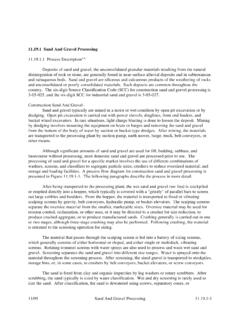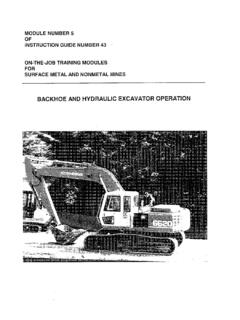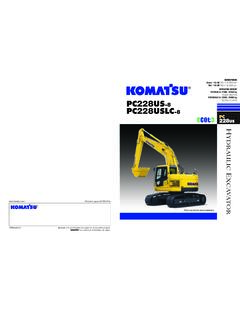Transcription of Are you making best use of lifting and handling aids?
1 Health and Safety Executive making the best use of lifting and handling aids Frequent and heavy lifting and handling can cause back injuries. But using lifting and handling aids can remove or reduce that risk and keep workers healthy and at work. This guidance is intended for managers, employees and their representatives and others involved in the selection of lifting and handling aids . Why are back injuries an issue? Back injuries from manual handling are a major cause of occupational ill health in the UK. But: they can often be prevented;. This is a web-friendly preventative measures can be cost-effective;. version of leaflet where back injuries occur, early reporting of symptoms, proper treatment and INDG398(rev1), suitable rehabilitation is essential. published 10/13. There are health and safety benefits for employers if they control manual handling risks by the use of lifting and handling aids such as: improved/maintained productivity.
2 Reduction in retraining costs;. limiting the options for liability;. reduction of injury/ill health to employees. Page 1 of 7. Health and Safety Executive Costs to employers case studies Case study 1 Case study 2. Manual handling injury claims cost In one year a firm lost 373 working a company 150 000 over a 3-year days because of manual handling period. This totalled 20% of their injuries. This cost about 24 000. employers' liability claims. in wages paid to absent workers. There were additional overtime Musculosketal disorders affecting payments and other costs. The the back are a common work- introduction of handling aids , related complaint reported through manual handling training, and a the Labour Force Survey (LFS) and rehabilitation programme reduced the latest results show an estimated days lost to 74 and wage costs to incidence figure of 51 000 cases for about 5000.
3 2011/12. The LFS estimated that the main work activities causing or making back disorders worse (averaged over the period 2009/10 2011/12). were: manual handling ( lifting /. carrying/pushing/pulling); awkward or tiring positions and workplace accidents. Costs to employees case studies Case study 1 Case study 2. A worker suffered back pain A worker was placing a heavy resulting from repetitive heavy length of timber on a stack when lifting . He was off work for eight it slipped. He tried to catch it and weeks on reduced earnings suffered an injury to his lower (sickness benefit). He was unable to back. He took bed rest and stayed enjoy his usual leisure activities and inactive for several weeks. He was was worried that he would not be not advised to keep active and the able to return to his normal job. To pain continued. Some months later prevent a recurrence, the company he received physiotherapy, but by installed a hoist which removed the this time the injury had become need for manual handling .
4 Chronic and the treatment did little to help. He is still in daily pain and can't stay sitting or standing for long. He is still unemployed several years later. making the best use of lifting and handling aids Page 2 of 7. Health and Safety Executive lifting and handling aids case studies Big bags handling kegs and cases of beer Employees manually feeding 25 kg Large containers and crates of sacks of material into a mixer had beer were frequently delivered back pain. Managers and employee into a deep public house cellar by representatives worked together lowering: to solve the problem. They started using bigger bags handled by lift kegs down a steep inclined skid truck and redesigned feed chutes, using a looped rope; and dust extraction etc to allow use of cases down a plank alongside big bags. This: the skid also using a rope. avoided the manual handling ; The kegs were sometimes reduced dust exposure; damaged and were difficult to reduced raw material costs; return up to street level.
5 Reduced loading times from an hour to 15 minutes, improving A powered cellar lift was installed production. which lowered/raised kegs and crates between street level and The trials were so successful the use the cellar floor. This avoided much of mechanically handled bags has of the strenuous manual handling been extended to all areas. and resulted in less damage to containers. Another problem is pushing empty beer kegs up skids from the pavement onto the brewery vehicle. This can be avoided by the provision of swing-lift hoists or side/. tail lifts on the vehicle. making the best use of lifting and handling aids Page 3 of 7. Health and Safety Executive How can you avoid or reduce the risk from frequent and heavy lifting ? Storing, Packing Packing and unpacking Bales, rreels, eels, barrel, Moving sheet sack,, box Bag, sack warehousing/orderr warehousing/orde pallets, stillages and drum,, drum materials etc handling picking containers keg handling trolleys, vehicles etc Powered trucks and Battery-operated truck Lift truck Pallet converter Drum/reel rotator Lift truck Non-powered trucks, trolleys and aids truck with Shelf trolley Pallet truck Pallet tilter Keg truck hydraulic lift slides/chutes/roller balls Tracks, conveyors, Conveyor with turntable Gravity rollers Roller track In-line weighing Ball table and rollers Adjustable height devices, rotary and tilt tables Some examples of solutions using lifting / handling aids .
6 Consider Adjustable height turntable Sheet/trolley table Auto-leveller Reel trolley Rotary table avoiding handling or reducing the unit weight too. Mechanical hoists and vacuum lifting devices Conveyor and vacuum hoist Vacuum hoist Tub hoist Reel lifting head Vacuum hoist W. ROW. RO. M. Other TV trolley with suction Gravity feed racking lifting hook Bin tilter Battery-powered tug cups making the best use of lifting and handling aids Page 4 of 7. Health and Safety Executive Goods Goods Portering, Portering, cleaning cleaning Setting Setting and and handling *. handling * dispatch/delivery dispatch/delivery to to and and waste waste maintenance maintenance tasks tasks site/domestic site/domestic premises premises etc and vehiclesetc trucksand trolleys,vehicles Poweredtrucks Powered trolleys, HGV-mounted HGV-mounted Stair Stair lift lift Powered Powered tug tug Hoist Hoist on on vehicle vehicle lift lift truck truck trucks, Non-poweredtrucks, aids andaids trolleysand Non-powered trolleys Stair- Stair-climbing climbing wheel wheelchair chair Cylinder Cylinder trolley trolley Wheeled Wheeled tool toolbox box Star- Star-wheeled wheeled truck truck balls slides/chutes/rollerballs conveyors, Tracks,conveyors, slides/chutes/roller Tracks, Sliding Sliding dies dies (low (low Van Van loading loading Slide Slide sheet sheet Mobile Mobile belt belt conveyor conveyor friction friction surface).)
7 Surface) boom boom and rotary and height Adjustable height tables devices,rotary tilt tables Adjustable devices, tilt Spring-loaded Spring-loaded Adjustable Adjustable height height bed bed laundry laundry trolley trolley Platform Platform truck truck Mobile Mobile conveyor conveyor devices and lifting devices hoists and Mechanical hoists vacuum lifting Mechanical vacuum Stand-aid Stand-aid hoist hoist Engine Engine hoist hoist Valve Valve lifting lifting jig jig Tail Tail lift lift Other Other Hand Hand rails rails Mop Mop bucket bucket on on wheels wheels Hand Hand protection protection Roll Roll cage cage * Take care to select aids which take clients' condition into account making the best use of lifting and handling aids Page 5 of 7. Health and Safety Executive lifting and handling aids case studies Order picking Stacking packaged items Staff selecting items for customer A firm identified production and orders from storage racking health and safety problems during suffered sore backs, necks and the manual stacking of packaged shoulders through repetitively items.
8 These were placed into stooping and reaching to pick up trays on a wheeled dolly at the the items. Installation of gravity end of each production line. The feed racking for many products tray stacking height varied as prevented the need to reach to more packages were added. An the back of the shelves. Heavier auto-leveller was provided to solve items were stored at waist height this problem. This improves the where they could be slid onto operator posture. The installation the collection trolleys. Turntables increased productivity by 45% and were provided, enabling pallets to controlled the risks. The capital be rotated once items had been payback time was five months. picked from the front, eliminating most of the reaching. Unpacking fruit Loading pallets Staff in a supermarket were Employees loading small packs experiencing back problems from of product from a conveyor stooping to empty fruit boxes from onto pallets frequently reported flat bed trolleys.
9 The company backache and had time off work. introduced a foot-operated The work involved repetitive hydraulic platform truck , so the bending and reaching across the boxes could be emptied at the pallet. The problem was solved by same height as the display fixtures, installing a scissor lift with turntable. which eliminated stooping. Other solutions for heavy items include the use of vacuum hoists or automatic palletisers. making the best use of lifting and handling aids Page 6 of 7. Health and Safety Executive Factors to consider when selecting lifting and handling aids Involve employees and safety representatives during assessment and when considering possible solutions, so that you can be sure what you propose will work in practice and won't introduce any new hazards. Seek advice from suppliers on the suitability of new lifting and handling aid equipment for your business.
10 Check equipment is CE-marked and within the safe working load. Consider what maintenance will be required. Consider whether the equipment will suit the area it will be used in, eg is there enough room to manoeuvre or enough headroom? Check that the equipment is suitable for the floor area in terms of stability and ground surface. Consider other factors associated with introducing lifting and handling aids , eg site safety, training, information and support. Where can you get more information about manual handling controls? Manual handling : Solutions you can handle HSG115 HSE Books 1994. ISBN 978 0 7176 0693 1 The HSE website, , contains: case study material about manual handling assessment and controls;. references for sector-specific manual handling guidance;. online training in the use of MAC, the Manual handling Assessment Charts. Assessment of repetitive tasks: ART tool INDG438 HSE Books 2010.















